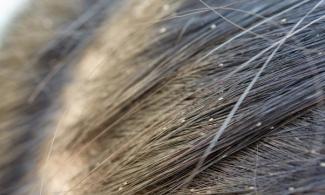
There is no sufficient evidence that the home remedies mentioned could cure head lice but they are believed to be rather dangerous to human health.
Claim: Viral reports claimed home remedies such as insecticides, kerosene mixed with substances like camphor kill head lice.
Verdict: There is no sufficient evidence that the home remedies mentioned could cure head lice but they are believed to be rather dangerous to human health.

Full Story
Social media is awash with success stories of do-it-yourself remedies for head lice, a very dreaded disease common among females.
Platforms such as YouTube are replete with videos showing how people reportedly got rid of lice using the various home remedies and urging the public to do the same.
One of such is this user who applied kerosene to a louse placed in a basin. In the video, she proved that kerosene could kill the louse. Another user recently gave the same advice.
Also, groups on Facebook, most especially those with titles such as 'Do-it-yourself' 'Home Remedies' among others, also are places where claims regarding hair lice are shared.
With over thousands of followers, the group members with such problems seek advice on how to get rid of hair lice and bring up age-long practices such as the application of insecticide to get rid of hair lice. Some also have recommended the use of Kerosene mixed with camphor as a head lice treatment as seen here, here and here.
Others have advised people with this challenge to make use of pain-relieving balm such as 'Aboniki' balm on the affected head because of the healing ability of the ointment.
This is despite stories of those who have been killed by these remedies, particularly a corps member in 2019 who applied Sniper insecticide to get rid of head lice in 2019.
Also, in 2020, a young woman was advised by her hairdresser to apply the same insecticide on the scalp of her two daughters to get rid of hair lice. While one died, the other was saved after much effort by medical practitioners.
What is head lice?
According to Medical News Today, head lice (singular louse) are tiny, wingless, parasitic insects that live in human hair. They are a common problem and highly contagious. They can also be hard to get rid of. The eggs are known as nits
They live in the hair on one’s head and feed off the blood from the scalp.
While head lice move from person to person, there is insufficient evidence to prove that it can be transmitted via inanimate objects such as comb, pieces of clothing of the affected persons among others.
However, while it has been said that head lice do not pose a very serious medical threat, they may cause the carrier to be uncomfortable, causing severe itching.
It has also been emphasized that having head lice does not mean the carrier is dirty.
“These pesky creatures don’t fly or jump -- they crawl over to the closest head they can find. This is called head-to-head contact, and most people get lice this way. But they also can spread onto hats, helmets, combs, bedding...”
Verification
Dubawa contacted Gogo James Owo, a clinical pathologist with De-Integrated Medical Diagnostics and Research Laboratories, Port Harcourt, Rivers State, who warned strictly against the use of kerosene/camphor, insecticide and other pesticides in getting rid of head lice. He said such home remedies are inimical to health.
“I will advise that people stay away from using Sniper because the active ingredient in Sniper pesticide is Bifenthrin. It is a highly toxic organic pollutant. When bifenthrin gets on the skin, it can cause tingling, itching, burning, or numbness at the site of contact. The sensations usually go away within 48 hours.
“However, inhaling bifenthrin can irritate the nose, throat, and lungs and in severe cases, respiratory damage is observed,” he said.
He also highlighted reasons why kerosene should never be applied to the scalp or any part of the body.
“Kerosene poisoning can cause symptoms in various parts of the body: it can cause breathing difficulty (from inhalation), it may cause throat swelling and the person may develop abdominal pain.
“Exposure to kerosene can also cause a person to start stooling blood, develop low blood pressure, convulsions, coma, dizziness among others."
He suggested the use of Dimethicone, a highly effective head lice treatment lotion, with a low risk of adverse effects. “Two applications of dimethicone one week apart results in successful eradication of lice in at least 70% of patients. Dimethicone is not an insecticide. It kills lice by suffocation and disrupting their ability to regulate water," Owo said.
The Center for Disease Control and Prevention also listed pediculicides (lice medicine) as the treatment for head lice.
It also stated that there are many head lice “over-the-counter” medications.
It noted that over-the-counter products approved by the FDA for the treatment of head lice contain one of the following active ingredients: pyrethrins combined with piperonyl butoxide; permethrin lotion.
Supplemental tips to be followed by people trying to get rid of lice infestations include: washing the hair with shampoo and using a nit comb; vacuuming furniture and floors, washing clothing worn or used by the infested person using hot water as lice and eggs are killed by exposure for 5 minutes to temperatures greater than 53.5°C (128.3°F).
It also warned against fumigant sprays stating, “insecticide sprays are not recommended and can be harmful to people and animals”.
Conclusion
The use of insecticide, kerosene for head lice removal can be dangerous. A person infested with head lice can consult a doctor if the over the counter remedies are not effective.
The researcher produced this fact-check per the Dubawa 2021 Kwame KariKari fellowship in partnership with SaharaReporters to facilitate the ethos of “truth” in journalism and enhance media literacy in the country.